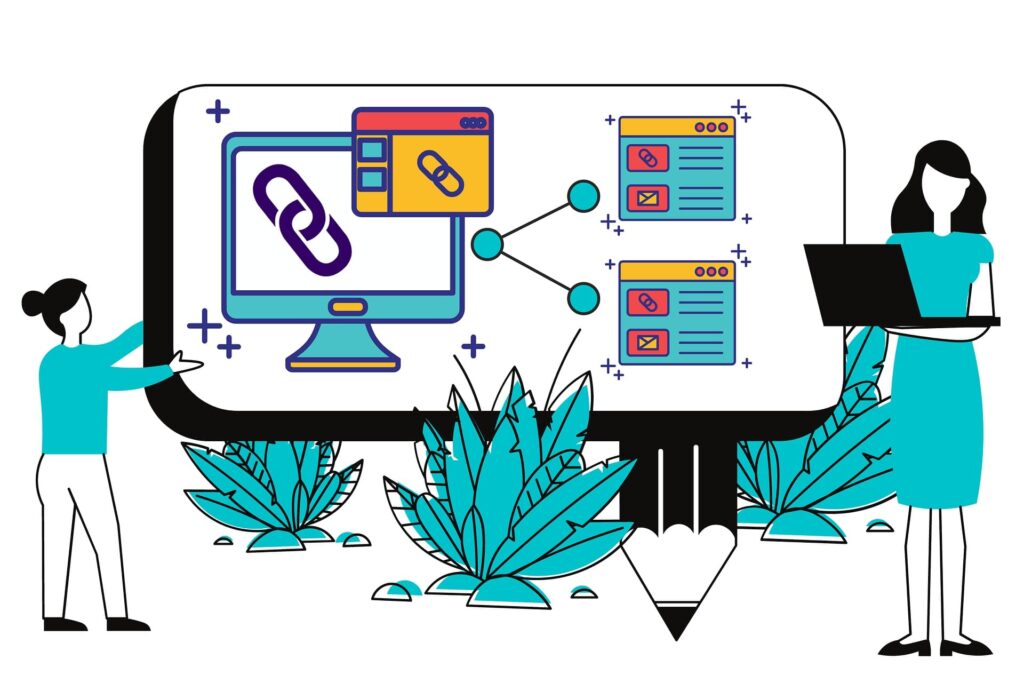Artificial Intelligence (AI) has revolutionized the writing and content creation process by providing a more efficient, reliable, and cost-effective way to create content.
AI-powered tools can help writers generate ideas, write articles, edit content, generate content marketing strategies and even optimize it for search engine optimization (SEO).
This ultimate guide will provide an overview of AI content creation and how it can be used to streamline the writing and content creation process. It will also discuss the use cases of AI writing tools, the advantages of using them, and some tips on how to get started with AI-powered content creation.
Quick Links
What is AI Content Creation
AI Content Creation is a process of creating content with the help of Artificial Intelligence (AI) technology. It is used to create content that can be used for marketing, advertising, and other promotional activities.
AI Content Creation helps to simplify the creation process by automating certain tasks, such as generating new ideas for blogging and editing existing content. It also enables copywriters to create high-quality content faster and more efficiently than ever before.
AI Content Creation can also be used to generate personalized recommendations based on user preferences and interests. This makes it easier for marketers to target their audience with relevant content that will help them achieve their goals.
How AI Can Generate Content
AI content creation is a rapidly growing field, as AI technology has become more accessible and affordable.
AI can create content through a variety of methods, including
Natural Language Processing (NLP): a field of AI that focuses on the interaction between computers and human language. NLP tasks include language translation, text summarization, sentiment analysis, and more. Example: A chatbot that can answer customer questions in natural language.
Machine Learning: Machine Learning is a branch of Artificial Intelligence that enables computers to learn from data and identify patterns without being explicitly programmed. Machine Learning algorithms can be used to generate and create content by analyzing large amounts of data and creating models that can predict future outcomes.
Large Language Model: a type of AI model that has been trained on a large dataset of text, allowing it to generate text that is similar to human writing. Example: GPT-3 is a large language model developed by OpenAI.
Generative Pre-training Transformer: a type of neural network architecture that is trained on a large dataset of text to generate new text that is similar to the training data. Example: GPT-3 is a generative pre-trained transformer.
Fine Tuning Process: the process of using a pre-trained AI model and adapting it to a specific task by training it on a smaller dataset. Example: fine-tuning a pre-trained language model to generate product descriptions for a specific e-commerce website.
State of the Art: the highest level of achievement in a field or technology. Example: GPT-3 is currently considered to be state-of-the-art in natural language processing.
Hyperparameters: the parameters of an AI model that are set before training, such as the learning rate and the number of hidden layers. Example: In a neural network, the number of hidden layers is a hyperparameter.
Sequence to Sequence Model: a type of neural network that is trained to map a sequence of input to a sequence of output. Example: A neural machine translation model is a sequence-to-sequence model that takes in a sentence in one language and generates a translation in another language.
Pointer Generator Mechanism: a mechanism used in sequence-to-sequence models to generate new words by pointing to the words in the input sequence rather than randomly sampling from the vocabulary.
Information Retrieval: the process of finding relevant information from a large collection of data, such as search engines. Example: Google is an example of an information retrieval system.
Few Shots Learning Technique: a machine learning technique that can learn new tasks with very few examples. Example: A model that can identify different animals after being trained on only a few images of each animal.
Opinion Mining: the process of using NLP techniques to automatically identify and extract subjective information from a text, such as opinions or emotions. Example: A sentiment analysis model that can determine if a customer review of a product is positive or negative.
Autoregression: a type of time-series modeling where the current value of a variable is predicted based on past values of the same variable. Example: A stock market prediction model that uses past stock prices to predict future prices.
Neural Text-To-Speech: AI technology that synthesizes natural-sounding speech from text input. Example: Google Assistant uses neural text-to-speech technology to generate speech in response to user queries.
End to End Automatic Speech Recognition Models: AI models that can transcribe speech to text without the need for intermediate steps like feature extraction or language modeling. Example: Google speech to text is an example of an end-to-end automatic speech recognition model.
Generative Adversarial Network (GAN): a type of neural network architecture that consists of two components, a generator and a discriminator, that work together to generate new data that is similar to the training data.
Types of AI Content Creation
From automating customer service responses to creating SEO-friendly articles, AI content creation is transforming the way businesses communicate with their customers and prospects.
Text Generation
AI text generation refers to the use of AI-based models to automatically generate text that is similar to human writing.
These models are typically trained on a large dataset of text, such as news articles, books, or social media posts.
The AI learns patterns and features of human writing through this process of training, and once trained, it can generate new text that is similar to the training data.
In the field of SEO, AI text generation can be used to automatically generate meta tags and descriptions that are optimized for search engines.
By analyzing the content of a webpage, the AI can generate meta tags and descriptions that include relevant keywords, making the webpage more likely to appear at the top of search engine results.
In the content creation and content marketing industries, AI text generation can be used to quickly and efficiently create high-quality content.
For example, a content marketing team can use an AI text generation tool to create blog posts, social media posts, or product descriptions, allowing them to focus on other aspects of content marketing, such as promotion and distribution.
In the blogging industry, AI text generation can be used to generate new articles on a wide range of topics, allowing bloggers to focus on other aspects of their blogs, such as promotion and monetization.
Additionally, AI models can also be used to generate summaries of long articles, making it easier for readers to quickly understand the main points.
Video Generation
AI-generated text-to-video is a new technology that has been gaining traction in recent years.
It uses natural language processing and machine learning algorithms to generate videos from the text.
This technology can be used for different use cases, such as creating explainer videos, marketing videos, and even personalized video stories.
AI-generated text to a video can help content creators save time and money while creating high-quality videos quickly and easily.
With the help of AI, content creators can create engaging videos with minimal effort and maximum impact.
It is an emerging technology that is revolutionizing the SEO, content creation, content marketing, and blogging industries. AI-generated videos are able to create high-quality videos from text and images with minimal human input.
This technology has enabled marketers to create engaging videos for their audiences quickly and cost-effectively.
It has also enabled bloggers to create unique, interesting, and informative videos for their viewers.
AI video generation is becoming increasingly popular as it offers a wide range of benefits such as faster production times, improved quality of content, and cost savings.
With its increasing popularity, it is expected that AI video generation will continue to revolutionize the SEO, content creation, content marketing, and blogging industries in the near future.
Image Generation
AI Image Generation is the process of creating images using artificial intelligence technology. This technology can be used to generate realistic images from scratch or to manipulate existing images.
AI Image Generation has become increasingly popular in recent years, with applications ranging from medical imaging to computer-generated art.
AI Image creation can be used for a variety of purposes, including creating virtual backgrounds for video conferencing, generating product images for e-commerce sites, and creating 3D objects for gaming and virtual reality applications.
Artificial intelligence (AI) has revolutionized the way images are generated and used in SEO, content creation, content marketing, and blogging.
AI-generated images enable marketers to create highly personalized visuals that can be used to engage with customers.
AI-generated images can also be used to optimize websites for search engines, increase website traffic and improve user experience.
Furthermore, AI-generated images have been used to create stunning visuals for blogs and social media posts that can help increase visibility and engagement.
In summary, AI-generated images have revolutionized the way we create content by making it easier to generate personalized visuals quickly and efficiently.
They are being increasingly adopted by marketers across industries as they provide a powerful tool for engaging customers, optimizing websites for search engines, and creating stunning visuals for blogs and social media posts.
Audio Generation
AI Audio Generation is an emerging technology that uses artificial intelligence (AI) to create audio files from text.
This technology can be used to generate voice-overs for videos, podcasts, audiobooks, and more.
AI Audio Generation can help content creators save time and money by quickly creating professional-quality audio files in a fraction of the time it would take to manually create them.
It also allows content creators to focus their time and energy on other aspects of their projects without having to worry about creating the audio themselves.
AI Audio Generation is becoming increasingly popular as it offers content creators a cost-effective way of producing high-quality audio files with minimal effort.
AI has revolutionized the way audio content is created, marketed, and consumed.
With AI-powered text-to-audio conversion technology, audio content can be created in minutes with the help of natural language processing (NLP) algorithms.
This has changed the way we create and consume audio content such as e-books, podcasts, radio programs, and more.
AI can also help to optimize existing audio content for better user engagement and higher ROI as it is a cost-effective and efficient method to produce audio content.
AI-generated audio content is now being used for a variety of purposes such as marketing campaigns, customer service automation, voice search optimization, and more.
Benefits of AI Content Creation
AI tools are becoming increasingly popular for content creation, and with good reason. AI-powered software can quickly create high-quality content that is tailored to the specific needs of businesses and organizations.
By using AI tools, businesses can save time and money while still creating engaging content that resonates with their target audience.
In this part, we will discuss the top ten benefits of creating content with AI tools and explore the pros of using AI software for content creation.
Efficiency: AI tools can generate large amounts of content quickly and efficiently, allowing content creators to focus on other aspects of their work.
Consistency: AI tools can generate content that is consistent in terms of style, tone, and format, making it easier to maintain a consistent brand voice.
Scalability: AI tools can generate content on a wide range of topics, making it easy to scale content production to meet the needs of a growing business.
Time-saving: AI tools can save time by automating repetitive tasks, such as generating meta tags and descriptions, allowing content creators to focus on more creative tasks.
Cost-effective: AI tools can reduce the cost of content production by eliminating the need for human writers and editors.
Personalization: AI tools can generate personalized content by analyzing data about individual users, such as their demographics and browsing history.
Language Translation: AI tools can translate text into multiple languages, making it easy to reach a global audience.
Optimization: AI tools can optimize content for different platforms and devices, making it more likely to be found and viewed by users.
Creativity: AI tools can generate new ideas and perspectives that humans might not have thought of, helping to create unique and engaging content.
Speed: AI tools can generate high-quality content in a fraction of the time it would take for humans to do the same job, making it possible to produce and publish content more quickly.
Limitations of AI Content Creation
AI content creation has been a growing trend in the digital age, offering potential benefits to both content creators and consumers. However, AI content creation also has its limitations and drawbacks. The top ten limitations of AI-generated content are as below:
Lack of Creativity and Originality
AI content creation has its limitations, the most important of which is the lack of creativity and originality. AI-generated content can be accurate and informative, but it lacks the spark of creativity that comes from human writers. AI-generated content can also struggle to capture emotions and feelings in a way that resonates with readers.
AI writers are unable to express complex ideas in an engaging manner or provide unique insights into topics that require more than just facts and figures.
They also cannot create stories or narratives, which is something that humans are much better at. This means that AI writers should not be used as a replacement for human copywriters but rather as an assistant to help them create better quality content faster.
Limited Understanding of Context and Audience
AI content creation has been gaining traction in the past years, but it still has its limitations. One of the main issues with AI content creation is that it lacks an understanding of context and audience.
AI copywriters are unable to understand the nuances of language and can only generate content based on what they have been programmed to do. This means that they cannot create content that is tailored to a specific audience or context.
In addition, AI copywriters are unable to pick up on subtle changes in tone or style, which can be important when creating content for different audiences. They also lack the creativity and emotional intelligence of human copywriters, making them less effective at creating engaging and meaningful content.
Potential for Bias
AI content creation has the potential to be biased, which can lead to inaccurate and misleading results. AI algorithms can learn from past data and make decisions based on that data, but if the data is biased or incomplete, then the algorithm may produce inaccurate results.
This can be especially problematic when it comes to creating content for marketing or advertising purposes. It is important to ensure that AI algorithms are trained on unbiased datasets in order to avoid any potential bias in the output.
Additionally, it is important to monitor the output of these algorithms regularly in order to ensure accuracy and fairness.
Limited Ability to Generate Persuasive or Emotional Content
AI content creation has its limitations when it comes to persuasive or emotional content.
AI can generate content quickly, accurately, and at scale but it lacks the human touch that is needed to create persuasive or emotional content. AI-generated content is often too robotic and lacks the subtlety and nuance of human copywriters.
AI can be used in some cases to generate basic copywriting such as product descriptions, blog posts, and other informational pieces.
However, when it comes to creating persuasive or emotional copywriting pieces such as ad campaigns or sales letters, AI falls short. Human writers are still needed to craft effective messages that will resonate with readers and evoke an emotional response.
Inability to Understand Sarcasm, Irony or Idiomatic Expressions
One of the key drawbacks of AI content creation is its difficulty in understanding sarcasm, irony or idiomatic expressions. This can be a major challenge when it comes to creating content that requires subtlety and nuance.
In order to create content that is engaging and accurate, AI writers need to be able to understand these subtleties in language. Otherwise, they may produce content that is not only inaccurate but also potentially offensive or even damaging for a company’s reputation.
As such, AI writers must be trained on how to interpret and express these types of expressions in order for them to be truly effective in creating quality content.
Errors in Grammar, Punctuation and Spelling
One of the main drawbacks of using AI writers is that they are prone to errors in grammar, punctuation and spelling. This can be a major issue for copywriters as it can lead to inaccurate or poorly written content.
AI writers are also not yet capable of understanding the nuances of language, which means they may struggle with more complex topics such as writing about emotions or cultural references.
Additionally, AI writers are unable to use creativity when writing content, meaning that their output may lack originality and freshness.
Lack of Cultural Sensitivity and Understanding
One of the most common limitations of AI content creation is its lack of cultural sensitivity and understanding. AI generated content can often be repetitive, generic, and insensitive to different cultures and contexts.
This can lead to issues such as inappropriate language or imagery that could be offensive to certain audiences.
Additionally, AI generated content may lack creativity and emotional depth which can make it difficult for readers to connect with the message being conveyed.
As a result, it is important for copywriters to understand the implications of using AI generated content in order to ensure that their message is communicated in a culturally sensitive manner.
Producing Plagiarised Content
Plagiarism is one of the major drawbacks of AI content creation. Even though AI writers can generate content at scale, they are not able to produce original and unique content without proper references.
AI writers are only able to generate content based on the data they have access to, which means that they can easily produce plagiarised content if the data sources are not properly referenced. This can be a major issue for companies who rely on their content to build their reputation and trust with customers.
As such, it is important for companies using AI writers to ensure that all data sources used by these AI writers are properly referenced so that their generated content is original and unique.
Incorrect and Outdated Facts and Figures
One of the biggest drawbacks of AI content creation is that it can produce incorrect and outdated facts and figures. This can be especially dangerous for businesses when using AI to create marketing materials or other types of copywriting.
AI content creators do not have the same level of knowledge as human copywriters, so they may not be able to identify incorrect or outdated information in their generated content. This can lead to inaccurate statements that could damage a company’s reputation or lead to legal issues if used in marketing materials.
To avoid this problem, companies should always double-check any facts and figures generated by an AI writing tool before publishing them. Additionally, businesses should make sure they are up-to-date with their research and use reliable sources when creating any kind of copywriting material.
Dependence on a Large Amount of High-Quality Training Data
One of the main limitation of AI content creation is its dependence on a large amount of high-quality training data. Without this data, AI content creation systems are unable to create accurate and effective content.
AI systems learn by analyzing existing data and using it to generate new content. This means that if the training data is not sufficient or of poor quality, then the generated content will also be of poor quality.
Furthermore, if the training data does not cover all possible scenarios, then the system may not be able to handle unexpected situations or requests and may produce inaccurate results. Therefore, it is important for AI systems to have access to a large amount of high-quality training data in order to produce accurate and effective results.
How to Choose the AI Content Creation Tool
AI content creation tools can be a great asset for businesses looking to create content quickly and efficiently.
With the right tool, businesses can save time, money, and resources while still producing quality content. However, it is important to choose the right AI content creation tool for your business needs.
Here are some tips to help you choose the best AI content creation tool for your needs:
Define your goals and requirements: Before you start looking for an AI content creation tool, it’s important to define your goals and requirements. What type of content do you want to create? What are the specific features or functionality that you need?
Research the market: There are many AI content creation tools available, so it’s important to research the market to find the best options for your needs. Look at the features and functionality of different tools, and read reviews and case studies to see how they have been used by other organizations.
Consider the cost: AI content creation tools can vary in price, so it’s important to consider the cost when making your decision. Determine your budget and look for tools that fit within it.
Evaluate the ease of use and integration: The tool should be easy to use and integrate with your existing systems and processes. Look for tools that have a user-friendly interface and offer good customer support.
Test the tool: If possible, test the tool before making a decision. This will give you a better idea of how well it will meet your needs and if it is the right fit for your organization.
Check for scalability and updates: Make sure the tool is scalable and can grow with your organization’s needs. Also, it should be continually updated to ensure it stays up to date with the latest trends and technologies.
By considering these factors, you can choose an AI content creation tool that will help you meet your goals and improve your content creation process.
Top Five AI Content Creation Tools
AI content creation tools are becoming increasingly popular for their ability to automate the process of content creation.
These tools use artificial intelligence (AI) algorithms to analyze data and generate content that is relevant and engaging. They can be used to create blog posts, web pages, product descriptions, and other types of written content.
The top five AI content creation tools are below:
Chat GPT
ChatGPT is a large language model developed by OpenAI that can generate human-like text. It can be used for a variety of tasks, including content creation, conversational AI, and language translation.
It can be fine-tuned to generate text based on a specific topic or style, and it can also be integrated into applications or websites to provide automated responses to users.
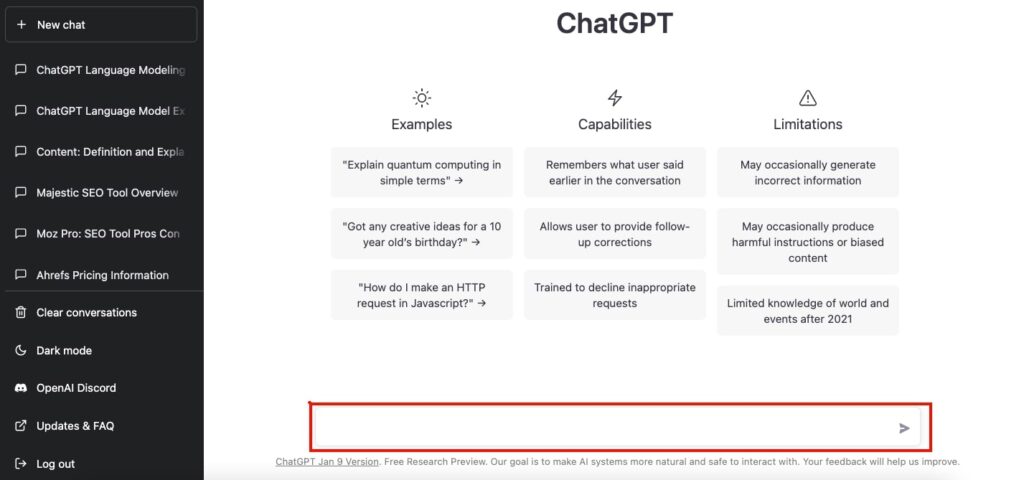
Rytr AI
Rytr AI is a revolutionary AI content creation tool that enables copywriters to generate high-quality, engaging content quickly and easily.
With Rytr AI, copywriters can use natural language processing (NLP) to create content that is tailored to the needs of their target audiences. It also helps them save time by eliminating the need for manual research and editing.
Rytr AI is an ideal solution for businesses looking to create valuable content at scale without sacrificing quality. It can also be used by digital agencies and freelancers who are looking for ways to streamline their workflow and boost productivity.
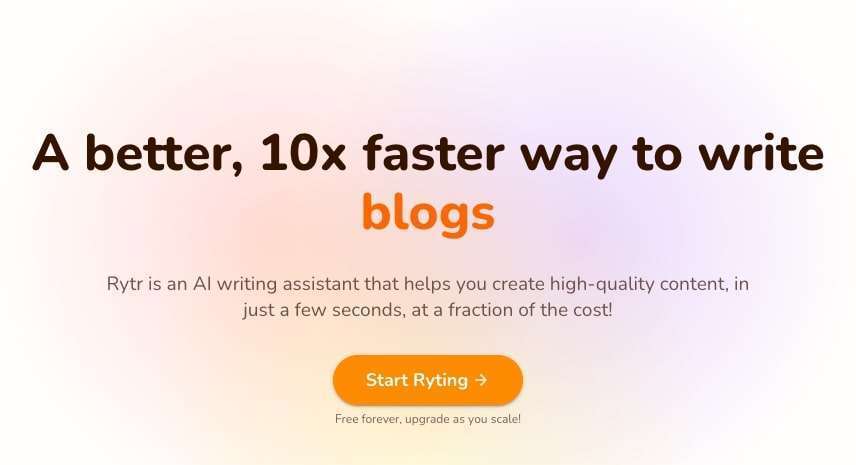
Jasper
Jasper AI is a widely used AI-powered content creation tool that helps copywriters, content writers, and digital agencies create high-quality content quickly.
It uses cutting-edge Natural Language Processing (NLP) technology to generate content from scratch or to help writers brainstorm ideas for existing pieces. With Jasper AI, copywriters can save time and energy by focusing on the creative aspect of their work while the AI takes care of the tedious parts like research and writing.
Additionally, it can be used to generate SEO-friendly articles that are optimized for search engine rankings.
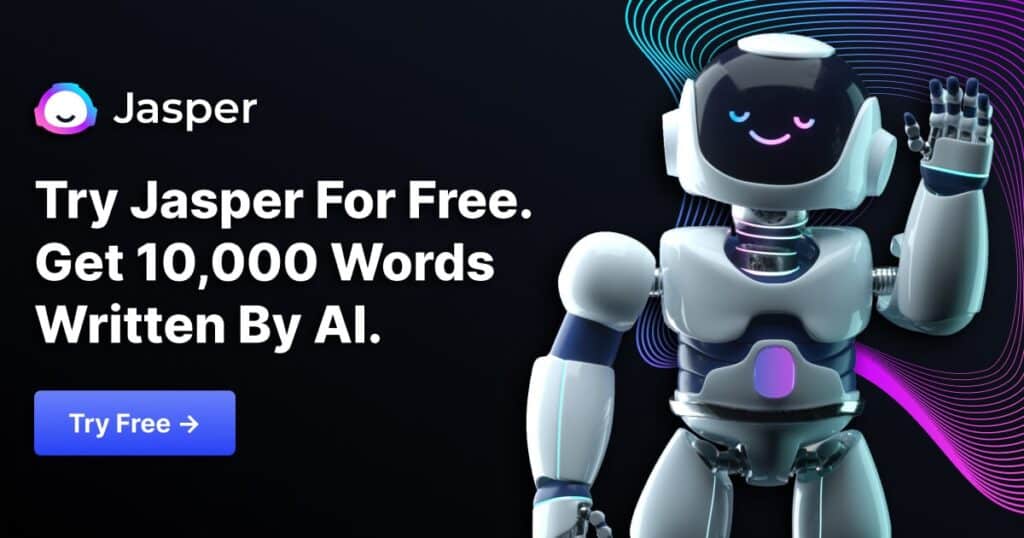
Growth Bar
Growth Bar AI Content Creation is an AI-powered content writing tool that helps businesses create high-quality, engaging, and optimized content quickly.
The tool uses natural language processing and machine learning to generate content for websites, blogs, social media posts, and more. It can also help with keyword research and SEO optimization.
With Growth Bar AI Content Creation, businesses can save time on creating content while ensuring it meets the highest standards in terms of quality, accuracy, and relevancy.
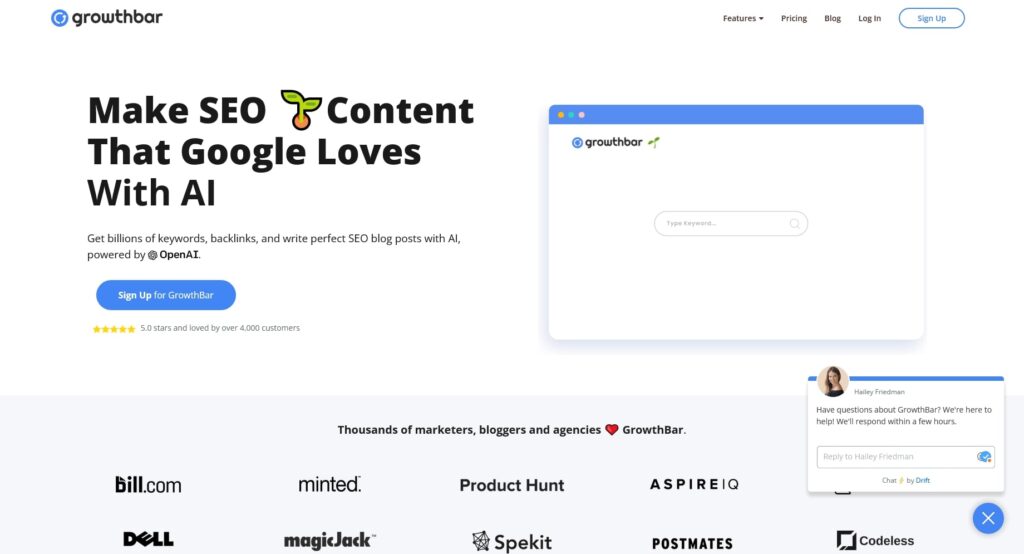
Copy AI
Copy AI Writing Tool is a revolutionary AI-powered content creation platform that is transforming the way writing and content generation are done.
It uses advanced natural language processing technology to generate high-quality content quickly and accurately. With Copy AI, writers can create compelling copy that resonates with their audience without spending hours on research or manually writing each sentence.
The tool also provides an array of features such as text analysis, keyword optimization, and automated grammar and spelling correction to ensure the highest quality of output.
By leveraging the power of AI, Copy AI Writing Tool is revolutionizing the way writers create content and allowing them to focus more on creativity rather than tedious tasks like proofreading or researching for facts.
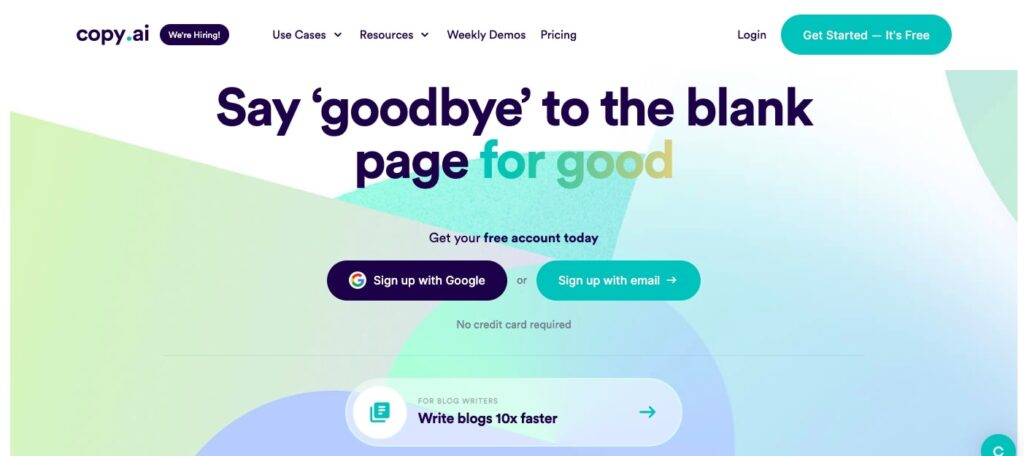
WriteSonic
WriteSonic AI Writing Tool is an advanced writing assistant that helps content writers to create high-quality content quickly and efficiently.
It features a wide range of features and benefits that make it stand out from other writing tools. It can generate ideas, provide feedback on grammar and spelling, suggest better words, and even help with SEO optimization.
With WriteSonic AI Writing Tool, copywriters can produce engaging content faster than ever before. The tool also offers the ability to collaborate with other writers in real time, making it easier for teams to work together on projects.
Additionally, the tool has a user-friendly interface that makes it easy for users to get started with the program without any prior knowledge or experience.

Bottom Line
Writing AI tools are software applications that use artificial intelligence (AI) and natural language processing (NLP) to generate written content. These tools can assist with tasks such as content creation, summarization, and language translation.
Benefits of using writing AI tools include:
- Saving time and effort on writing tasks
- Increasing productivity
- Potentially improving the quality of the written content
Common features of writing AI tools include:
- The ability to generate text in a specific style or tone
- The ability to fine-tune the model to a particular topic or industry
- Integration with other tools or platforms
Pros:
- AI writing tools can help to save time and effort on writing tasks
- They can increase productivity and potentially improve the quality of the written content
- AI writing tools can help to generate unique and engaging content
Cons:
- AI writing tools can be expensive
- They may not produce content that is as high quality as content written by humans
- They can’t understand or replicate human emotions and feelings
Impact on SEO, Content Creation, Content Marketing, and Blogging:
- AI writing tools can generate SEO-friendly content, helping to improve the visibility of your website in search engine results.
- They can be used to create a large amount of unique and engaging content, which can be beneficial for content marketing and blogging.
- AI writing tools can assist in creating high-quality, consistent, and unique content, which can lead to increased traffic and engagement.
However, it is worth noting that the use of AI writing tools should be balanced with human oversight and editing. They are tools to assist and supplement human writing, not replace it. The content generated by AI tools should be proofread and edited by humans before publishing.
Sharing is Caring

























